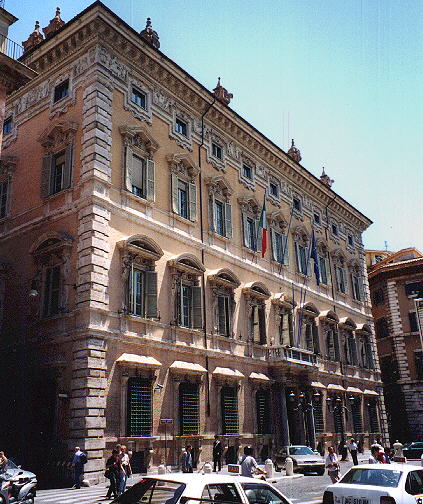

Palazzo Madama (Book
4) (Map
C2) (Day 4) (View C6) (Rione Sant'Eustachio)
In this page:
The plate by Giuseppe Vasi
Today's view
Palazzo Carpegna
The Plate (No. 70)
Palazzo Madama owes its name to the fact that here lived for a while
Margaret, daughter of Charles V, who had married Alessandro de' Medici,
whose family owned the Palace (she gave her name also to Villa
Madama and the town of Castel Madama). After the extinction of the Medici family in 1737, it
was bought by Pope Benedictus XIV, whose coat of arms is clearly noticeable
over the entrance. The view is taken from the green dot in the small 1748 map here below.
In the description below the plate Vasi made reference to: 1) Palazzo Carpegna (today largely modified);
2) The spiral of S. Luca (S. Ivo) alla
Sapienza; 3) Palazzo
Giustiniani;
4) Chiesa del SS. Salvatore. 2) and 3) are shown in other pages.
The small map shows also 5) Palazzo Madama.
Today
Palazzo Madama is today the meeting place of the Italian Senate and it
is well preserved. The façade, built in 1642 by Paolo Marucelli has a very
rich decoration (my background shows a detail of the windows of the main
floor). The top windows have very elegant reliefs, but what is really unique
is the relief over the main entrance: not a lion, but the skin of a lion
greets the visitors. The street to the left of the palace retains the name
of the little church shown in the plate (SS. Salvatore) pulled down to
enlarge Palazzo Madama.
Palazzo Carpegna
Palazzo Carpegna was pulled down and rebuilt in 1926-29. It was originally built towards the end of the XVIIth century and it is
generally attributed to Giovanni Antonio De Rossi. The Carpegna had another palace near Fontana di Trevi.
The image shows the portal and the rear façade opposite which a fountain was placed in 1987. It consists of a large Roman granite basin found in the courtyard of Palazzo Madama.
Excerpts from Giuseppe Vasi 1761 Itinerary related to this page:
Palazzo Madama
Prese un tal nome questo magnifico palazzo, perchè edificato alla Principessa Caterina de' Medici
figlia del Gran Duca di Toscana, e vi abitò prima, che fosse Regina di Francia, e poi vi nacque il
grande Alessandro Farnese. Furono in questo luogo le magnifiche terme di Nerone, poi, come
diremo,accresciute da Alessandro Severo, e rendute colla sua casa, che quì presso aveva, più
deliziose, delle quali si videro fino ai nostri tempi nel secondo cortile di questo palazzo le
maravigliose rovine con un grande arco di materia laterizia, e vi era nel mezzo un grande albero
con un fonte da piede, che per verità sembrava un incantesimo. Fu il tutto demolito per dar luogo alla
fabbrica della nuova abitazione per la famiglia bassa del Tribunale del Governo di Roma, ora quì
stabilito, con tutti i Notari, Luogotenenti, ed altri ministri.
Nel nono anno del suo Impero edificò queste terme Nerone, e furono di tanta magnificenza, e con tanto lusso
tenute, che Marziale ebbe a dire nel settimo delle sue epigramme:
. . . . . . quid Nerone pejus?
Quid Thermis melius Neronianis?
Ma Alessandro Severo per abolire il nome di quel infame Imperatore, e per dare applauso maggiore
alle terme, dopo averle accresciute di fabbrica, e di delizia, volle che le medesime a pubblico comodo
fossero illuminate di notte con quantità di lampadari di cristallo di monte.
Da Greci appresero i Romani l'uso di bagnarvisi, prima della venuta de' Medici, il che avvenne circa
l'anno 535. dalla fondazione di Roma nel consolato di L. Emilio, e M. Licinio; e la loro introduzione fu
per motivo di pulizia, poichè in quei tempi costumavansi i panni di lana invece di quelli di lino, non
ancora introdotti, come oggidì, e similmente per maggior conservazione della salute; benchè di poi
si ridusse in lusso, e delizia; e però vi concorrevano i Romani non solo a pulire, ma ricreare ancora a i
loro corpi. Erano in esse compartite quasi infinite stanze a volta, alcune con acque tiepide, e talvolta
odorifere, destinate a i lavacri, ed altre con i soli vapori calidi per rifocillarsi ne' tempi d'inverno,
ungendosi ancora con olj, ed unguenti prelibati; e vi erano similmente luoghi, a parte destinati per le
sole donne.
Inoltre esercitavano nelle terme la lotta, il disco, il salto, il pugliato, il corso la palla, e vi furono anche
introdotte le palestre, i ginnasj, le biblioteche, e per maggior delizia vi furono formate amenissime selve
atte a spasseggiarvi. P. Vittore ne descrive dodici, e le chiama Cesaree, e de' bagni privati ne conta
ottocento sessanta, ma poi sotto Nerone giunsero ad un numero esorbitante.
E' tradizione, che in queste terme fosse stato un tempio della Pietà, e che poi da s. Silvestro fosse dedicato
al ss. Salvatore, e dopo consacrato da s. Gregorio Magno, li conferisse molte indulgenze, il quale si
disse s. Salvatore in Thermis, e poi s. Giacomo in Thermis, a cui era unito un spedale. Questo, forse
sarà quella chiesa, che ora è unita al suddetto palazzo Madama, che diciamo ss. Salvatore.
|
Next plate in Book 4: Palazzo Sacchetti sulla Strada Giulia
Next step in Day 4 itinerary: Chiesa di S.
Luigi dei Francesi
Next step in your tour of Rione Sant'Eustachio: Convento di S. Agostino

Go
to  or to Book
4 or to my Home
Page on Baroque Rome or to my Home Page on Rome
in the footsteps of an XVIIIth century traveller.
or to Book
4 or to my Home
Page on Baroque Rome or to my Home Page on Rome
in the footsteps of an XVIIIth century traveller.
|









